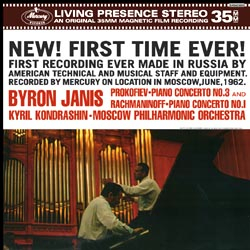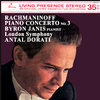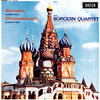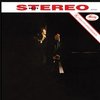AAA 100% Analogue This LP was Remastered using Pure Analogue Components Only from the Master Tapes through to the Cutting Head
Speakers Corner / Mercury Living Presence - SR90300 - 180 Gram Virgin Vinyl
Pure Analogue Audiophile Mastering - Pressed at Pallas Germany
The Absolute Sound Super Disc List TAS Harry Pearson Super LP List
Sergej Prokofiev: Piano Concerto No. 3 in C Major, op. 26
Serge Rachmaninov: Piano Concerto No. 1 in F Sharp Minor op. 1
Byron Janis and the Moscow Philharmonic Orchestra conducted by Kyril Kondrashin
TAS Super Disc Recording Now Back In Print
Vinyl lovers like those from Speakers Corner can lament about how difficult it can be to dig up audio treasures and enhance them to make them as fresh and new. A good mastertape and precise cutting is of prime importance, of course. But a collector's heart will also miss a beat when taking a look at the original cover. Record dealers know this only too well and demand a high price for rare original recordings, as though they were dealing in gold. The rarer the recording, the more expensive it comes. In order to close the gap between the demand for coveted LPs and the potential for speculation with such productions, Speakers corner are re-releasing a number of first-class recordings by Mercury and Decca. All the titles appeared in their catalogue but were sold out years ago.
Janis's true genius shows itself in the fresh and fiery keyboard magic in Prokoviev's Piano Concerto no. 3 and his highly sensitive personal style in Rachmaninoff's First Piano Concerto.
In contrast to his tremendously popular Second and Third Piano Concertos, Rachmaninov’s First could be likened to a rare orchid in that it is seldom found on a concert programme. Why is that? Is it that it lacks the sweet sultriness of the later works? Or could it be that no one is aware of the 17-year-old composer’s talents
Or can he be accused of walking in Tchaikovsky’s harmonic footsteps This recording has an answer to all these questions. In spite of reaching back to such genial examples as Schumann, Beethoven and Grieg, Rachmaninov reveals his own personality in his early work. The thematic ideas are extremely impressive, they are developed skillfully, and are treated to such a masterly orchestration that one is tempted to dub this work “The Underestimated”.
Prokofiev’s Third Piano Concerto was spared such a fate. Its folklike character, coupled with amazing virtuosity, guarantee that the work remains immensely popular – but it also places the highest demands upon the performers. It remains a matter of speculation as to whether the presence of the American recording team spurred on the Moscow Philharmonic Orchestra and the pianist Byron Janis to newer and greater heights, such as are heard here.
We are happy to be able to include this valuable recording in our Russian Edition.
Recording: June 1962 in Bolshoi Hall of the Tchaikovsky Conservatory, Moscow, Russia,
by C.R. Fine and Robert Eberenz / Production: Wilma Cozart
Musicians:
Byron Janis, piano
Moscow Philharmonic Orchestra
Kyril Kondrashin, conductor
Selections:
Sergei Prokofiev (1891-1953)
1. Piano Concerto No. 3 in C Major, op. 26
Sergei Rachmaninoff (1873-1943)
2. Piano Concerto No. 1 in F Sharp Minor, op. 1
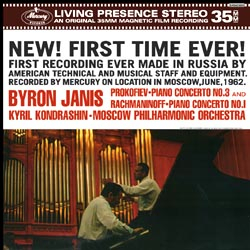
25 Years pure Analogue
Are your records completely analogue?
Yes! This we guarantee!
As a matter of principle, only analogue masters are used, and the necessary cutting delay is also analogue. All our cutting engineers use only Neumann cutting consoles, and these too are analogue. The only exception is where a recording has been made – either partly or entirely – using digital technology, but we do not have such items in our catalogue at the present time
Are your records cut from the original masters?
In our re-releases it is our aim to faithfully reproduce the original intentions of the musicians and recording engineers which, however, could not be realised at the time due to technical limitations. Faithfulness to the original is our top priority, not the interpretation of the original: there is no such thing as a “Speakers Corner Sound”. Naturally, the best results are obtained when the original master is used. Therefore we always try to locate these and use them for cutting. Should this not be possible, – because the original tape is defective or has disappeared, for example – we do accept a first-generation copy. But this remains an absolute exception for us.
Who cuts the records?
In order to obtain the most faithful reproduction of the original, we have the lacquers cut on the spot, by engineers who, on the whole, have been dealing with such tapes for many years. Some are even cut by the very same engineer who cut the original lacquers of the first release. Over the years the following engineers have been and still are working for us: Tony Hawkins, Willem Makkee, Kevin Gray, Maarten de Boer, Scott Hull, and Ray Staff, to name but a few.
At the beginning of the ‘90s, in the early days of audiophile vinyl re-releases, the reissue policy was fairly straightforward. Companies such as DCC Compact Classics, Mobile Fidelity, Classic Records and others, including of course Speakers Corner, all maintained a mutual, unwritten code of ethics: we would manufacture records sourced only from analogue tapes.
Vinyl’s newfound popularity has led many other companies to jump on the bandwagon in the hope of securing a corner of the market. Very often they are not so ethical and use every imaginable source from which to master: CDs, LPs, digital files and even MP3s.
Even some who do use an analogue tape source employ a digital delay line, a misguided ’80s and ‘90s digital technology that replaces the analogue preview head originally used to “tell” the cutter head in advance what was about to happen musically, so it could adjust the groove “pitch” (the distance between the grooves) to make room for wide dynamic swings and large low frequency excursions. Over time analogue preview heads became more rare and thus expensive.
So while the low bit rate (less resolution than a 16 bit CD) digital delay line is less expensive and easier to use than an analogue “preview head”, its use, ironically, results in lacquers cut from the low bit rate digital signal instead of from the analogue source!
Speakers Corner wishes to make clear that it produces lacquers using only original master tapes and an entirely analogue cutting system. New metal stampers used to press records are produced from that lacquer. The only exceptions are when existing metal parts are superior to new ones that might be cut, which includes our release of “Elvis is Back”, which was cut by Stan Ricker or several titles from our Philips Classics series, where were cut in the 1990s using original master tapes by Willem Makkee at the Emil Berliner Studios. In those cases we used only the original “mother” to produce new stampers.
In addition, we admit to having one digital recording in our catalogue: Alan Parsons’ “Eye in the Sky”, which was recorded digitally but mixed to analogue tape that we used to cut lacquers.
In closing, we want to insure our loyal customers that, with but a few exceptions as noted, our releases are “AAA”— analogue tape, an all analogue cutting system, and newly cut lacquers.
The sound in both performances is outstanding. Anyone wanting to hear what is wrong with digital sound need only listen to the end of the Scherzo capriccioso. There is depth and width, huge presence, every section of the orchestra is clearly audible (the final timpani role is startlingly realistic) the timbre of each instrument can be heard, and the ersatz quality found in even the best quality 24bit high-resolution recordings is completely absent. With regard to the human voice, again there is a sense of richness and natural resonance that places Nilsson very firmly in your living room, and to hear her and the Vienna Philharmonic exult takes your breath away.
Both recordings were compared with first-label pressings, and in both cases the Speakers Corner discs have more projection, power and a better controlled bass. Cheap they are not, but if anyone wonders why increasingly large numbers of people rave about vinyl, then these discs demonstrate why.
Audiophile Vinyl - Made in Germany For over 60 years the family business in the third generation of the special personal service and quality "Made by Pallas" is known worldwide. Our custom PVC formulation produces consistently high pressing quality with the lowest surface noise in the industry. Our PVC complies with 2015 European environmental standards and does not contain toxic materials such as Lead, Cadmium or Toluene. Our vinyl is both audiophile and eco-grade!
